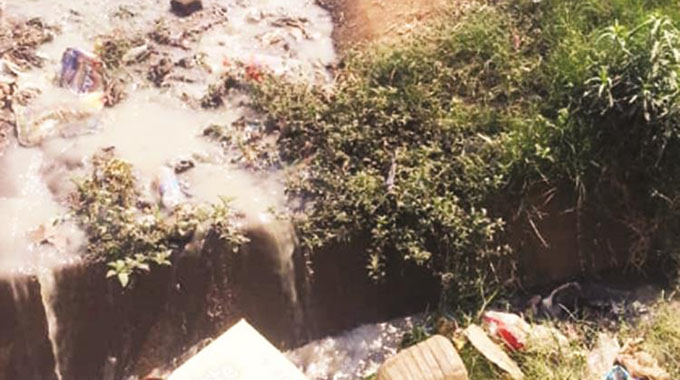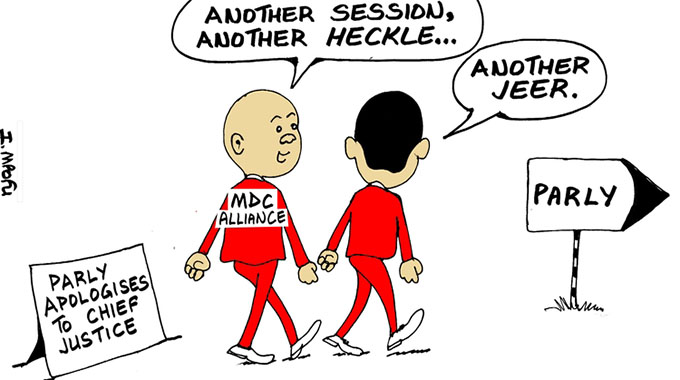Tracing the origins of misery

Leroy Dzenga Features Writer
A reputation for typhoid and cholera outbreaks has developed in Glen View, Budiriro and other south-western suburbs judging by recent trends.
As in the year 2008 when Zimbabwe had the last widespread cholera outbreak, Budiriro was the epicentre of the outbreak.
A decade later, Glen View 3’s, Tichagarika area is the focal point of cholera cases that have seen Government, the corporate world, civil society and individuals joining hands to fight the water-borne disease that thrives in filthy conditions.
What fed the crisis we are currently grappling with?
Sewer pipes near the shops burst and effluent was seeping into groundwater sources where the boreholes at the shopping centre draw their water.
Food vendors at the shopping centre relied on the boreholes on the assumption they were safe sources of water.
The boreholes have since been decommissioned by the Harare City Council.
According to Vincent Nyathi, a resident in Glen View 3, many patronised the makeshift takeaways whose meals were prepared using the contaminated borehole water.
“The headmaster from a local college who died from cholera, Mr Rodwell Samukange, used to buy his meals from food vendors at the shopping centre. He was a well-known patron. I suspect that is where he got infected with cholera,” said Tendai Chaokera, a Glen View 3 resident.
“Many who buy their food from those open door kitchens have fallen ill. They were attracted to cheap prices which are very low in comparison to reputable retailers. The popular meal -sadza and beans – cost 50 cents, in a five-day week you would have spent just $2, 50 on lunch. This is why people rush to these spots even in the face of apparent danger,” Chaokera said.

Residents fetch clean water from a bowser as Government and the corporate sector respond to the outbreak
Breaking bulk appears to be the central economic activity at Tichagarika Shopping Centre where commodities like maize-meal are repackaged into small packets, commonly called “tsaona”, for resale.
Cooking oil is sold in small containers and buckets carry meat which is consumed by many households.
Despite the obvious hygiene concerns, many around Tichagarika Shopping Centre survive on these repackaged commodities.
When The Herald visited Glen View 3 on Friday, police officers were dispersing vendors whose activities perpetuate the spread of infectious pathogens.
Many vendors were fleeing temporarily, only to return to their spots after the law enforcement officers had left.
Such defiant and unwittingly reckless behaviour has contributed to the spread of the highly contagious disease.
After the outbreak intensified the City of Harare moved in to replace blocked pipes in Glen View 3’s First Avenue where effluent flowed through many a family’s doorstep.
Mrs Florence Muzekenyi’s home was one of those affected, the sewage trail which ran along First Avenue originated from her home.
She considers the late response by the authorities as part of the crisis Glen View and the country finds itself in.
“Council came here late, they took action after the situation had already gotten out of hand. The speed with which they came to fix this after the whole country got concerned speaks of complacency. It shows that they have the capacity, but they were deliberately dragging their feet,” Mrs Muzekenyi said.
For more than three weeks, the Muzekenyi family had been living in constant fear that the continued exposure to sewage could have undesirable consequences.
“With our kids the only solution is to ensure that they do not play outside, my concern is with my child who is in Grade Seven. The best we can do is to constantly remind them to try and take precautions when they go to school. These are not easy times,” said Muzekenyi.
“We need proper policies that ensure that there is scheduled maintenance work on pipes before people’s lives are put in danger. Council should also be prompt in responding to issues and not wait for people to die before they take action,” she said.
A City of Harare engineer who has been working in Glen View replacing pipes told The Herald that lack of discipline on waste disposal partly contributed to the outbreak.
“It is no secret that these pipes are old, but people here are worsening the situation by dumping waste through sinks and toilets. We removed heaps of diapers and sanitary pads from these pipes when we were replacing them. These are the things that put pressure on the pipes causing them to burst,” he said.
“Spoons, clothes made up most of the objects we retrieved. This is a problem with most high-density suburbs, I have worked in Kuwadzana, Mufakose and the situation is still the same.
‘‘People here use squat holes, which make it easier to flush things which are not meant to be disposed through the toilet unlike where there are toilet seats. Old pipes are weak and it does not help to load them with things that will add more pressure on them. This is why we have these bursts,” he said.
There have been suggestions that the western suburbs’ proximity to Firle Wastewater Treatment Plant could be a factor in the recurrence of cholera cases.
Hardlife Mudzingwa, a programmes manager at water preservation lobby group Community Water Alliance, said it was highly unlikely that there was a direct link between the disease outbreak and Glen View’s proximity to a sewer management facility.
“Proximity to Firle Wastewater is not a contributing factor. If treatment plants were to cause outbreak, what is transpiring at Crowborough Wastewater plant could have claimed millions because it’s worse,” said Mudzingwa.
Again, the city’s slow reaction to reported cases was cited as a key factor.
“What contributed to cholera are unattended sewer bursts in Glen View particularly in Crescents 70, 71, 72, 73, 74, 75, 76 and First Crescent. The local district office was informed, but they were reluctant to act,” said Mudzingwa.
To stop Glen View and surrounding areas from being notorious epicentres of water-borne diseases Mudzingwa suggested three long-term solutions;
Replacement of both sewer and water pipes that are now old and dilapidated. This should be complemented by rehabilitation of wastewater treatment plants.
Increasing National Budget allocation to water and sanitation. Possibly 10 percent of National Budget must be allocated to water and sanitation every year. The Budget must be complemented by a strcict infrastructure maintenance policy.
Preservation of wetlands to secure sustainable fresh and quality water supply.
While the reactive maintenance work has begun in Glen View 3 and surrounding areas, it remains to be seen whether the city fathers are serious about upgrading pipes or these are just face saving optics in times of crisis.
As the western suburbs are home to a significant percentage of Harare’s population, urgent action needs to be taken to save lives now and in the future.
Authorities must look into why these areas have been afflicted by cholera and typhoid since the turn of the millennium.









Comments